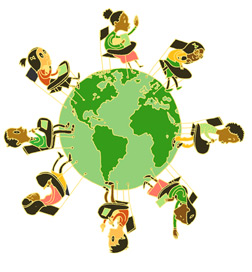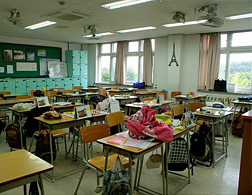Brilliance in a Box
What do the best classrooms in the world look like?
Posted Wednesday, Oct. 20, 2010, at 3:33 AM ET Imagine if we designed the 21st-century American classroom to be a place where our kids could learn to think, calculate, and invent as well as the students in the top-performing countries around the world.
Imagine if we designed the 21st-century American classroom to be a place where our kids could learn to think, calculate, and invent as well as the students in the top-performing countries around the world.What would those spaces look like? Would students plug into mini-MRI machines to record the real-time development of their brains' executive functions? Would teachers be Nobel Prize winners, broadcasting through screens installed in the foreheads of robots that don't have tenure?
Classrooms in countries with the highest-performing students contain very little tech wizardry, generally speaking. They look, in fact, a lot like American ones—circa 1989 or 1959. Children sit at rows of desks, staring up at a teacher who stands in front of a well-worn chalkboard.To find out, we don't have to travel through time. We could just travel through space. At the moment, there are thousands of schools around the world that work better than our own. They don't have many things in common. But they do seem to share a surprising aesthetic.
"In most of the highest-performing systems, technology is remarkably absent from classrooms," says Andreas Schleicher, a veteran education analyst for the Organization for Economic Cooperation and Development who spends much of his time visiting schools around the world to find out what they are doing right (or wrong). "I have no explanation why that is the case, but it does seem that those systems place their efforts primarily on pedagogical practice rather than digital gadgets."
Advertisement
 And yet, when politicians and bureaucrats imagine the classroom of the future, they often talk about a schoolhouse that looks like an Apple store, a utopia studded with computers, bathed in Wi-Fi, and wallpapered with interactive whiteboards (essentially giant touch screens used in place of chalkboards in more and more classrooms nationwide). "In the 21st century," Education Secretary Arne Duncan said in a speech in Washington, D.C., this March, "schools can't be throwbacks to the state of education 50, 20, or even 10 years ago. … We must make the on-demand, personalized tech applications that are part of students' daily lives a more strategic part of their academic lives."
And yet, when politicians and bureaucrats imagine the classroom of the future, they often talk about a schoolhouse that looks like an Apple store, a utopia studded with computers, bathed in Wi-Fi, and wallpapered with interactive whiteboards (essentially giant touch screens used in place of chalkboards in more and more classrooms nationwide). "In the 21st century," Education Secretary Arne Duncan said in a speech in Washington, D.C., this March, "schools can't be throwbacks to the state of education 50, 20, or even 10 years ago. … We must make the on-demand, personalized tech applications that are part of students' daily lives a more strategic part of their academic lives."But the most innovative schools around the world do not tend to be the ones with the most innovative technology inside them. To American exchange students, the difference can be disorienting. Kristin De Jesus is currently attending a public school in South Korea through an international study program called Youth for Understanding. De Jesus came to Korea, which consistently ranks at the top of the world in international exams, from a high school outside of San Diego, where she would be a junior.
In her Korean school, near Seoul, her classmates have iPod touches and iPhones and play Nintendo, just like her classmates in America. But the classroom itself is austere. "In California, we use white boards, while in Korea they use chalkboards," she says. "There is a dirt field outside. We have a projector, that's about it." Back home, teachers would hand out Mac laptops for kids to work on in class. But in Korea, the only computers are older PCs, and they remain in the computer lab, which is used only once a week for computer class.
 So how to explain that these old-fashioned classrooms tend to crank out kids who possess far more of the math and science skills valued by modern-day employers? For one thing, while the American school day can be as short as six hours, Korean kids attend school about eight or nine hours a day—and then many of them continue studying alone or with tutors until late into the night. Korean parents also put enormous pressure on kids to study. "The American system is a lot easier," De Jesus says. "When I was in California, I barely ever studied and did pretty well in my classes."
So how to explain that these old-fashioned classrooms tend to crank out kids who possess far more of the math and science skills valued by modern-day employers? For one thing, while the American school day can be as short as six hours, Korean kids attend school about eight or nine hours a day—and then many of them continue studying alone or with tutors until late into the night. Korean parents also put enormous pressure on kids to study. "The American system is a lot easier," De Jesus says. "When I was in California, I barely ever studied and did pretty well in my classes."School does not have to be grueling to be good. In Finland, the schools have almost nothing in common with the pressure-cooker classrooms of Korea. Finnish students start going to school a year later than American kids, and they do less homework on average. Standardized tests are rare. And yet, in 2006, Finnish teenagers ranked first in math and science among 30 OECD countries. (The United States ranked 25th in math and 21st in science.)
Around the world, countries have found a variety of ways to make schools work—even for poor kids or immigrant kids. They spend less money per pupil than we do but distribute it more efficiently and more equitably. More importantly perhaps, school systems in Singapore, Finland, and Korea recruit 100 percent of their teachers from the top one-third of their academic cohort, according to a 2010 McKinsey & Co. report, "Closing the Talent Gap."In the United States, about 23 percent of new teachers—and only 14 percent in high-poverty schools—come from the top one-third. "It is a remarkably large difference in approach, and in results," the report concludes.
Even within the United States, the best schools are not the most tricked-out ones. In Southeast D.C., Lisa Suben teaches fifth-grade math at KIPP DC: AIM Academy, one of 99 Knowledge Is Power Program charter schools around the country. When her students come into her classroom, they perform about two years behind, on average. By the time Suben has had nine months with them, they are mastering grade-level work.
Watching Suben teach on a recent October afternoon, I initially forgot to note whether her classroom contained any modern-day technology. Her class of 31 African-American students sat spellbound as she led them in call-and-response chants to practice their multiplication tables, pasted stickers on their foreheads for getting questions right, and timed how long it took them to get all their homework into a pile in the first row (18 seconds).
Finally, I remembered why I was there. I counted four computers in the back of the room, an ink-jet printer, and an overhead projector that looked to be at least 15 years old. Later, I asked Suben, who has been teaching for eight years, what the perfect classroom would look like. "If I were designing my ideal classroom, there'd be another body teaching. Or there'd be 36 hours in the day instead of 24."
Suben, like most great teachers, is in a hurry. She said computers can be useful, but mostly because they save her time—by assessing what her kids know more efficiently than she can. Three times a year, her students take computer-adaptive tests, which get harder as the student goes along. Suben gets the results instantly, which means she can see how a student is doing compared with the other kids in her class, the school, and around the country. "It might say, 'You know how to round to the hundreds, but you don't know how to round to the thousands?' That's, for me, an aha moment."
Ask middle-school teachers what they would like to change about classroom design, and they suggest a bathroom for the kids. When I ask Suben which gadget she would bring with her if she had to teach on a desert island, she chooses the overhead projector, without hesitation. "I wouldn't be able to give up the overhead, because then I'd have to turn my back to the class," she said. The oldest technology in the room is the one that helps her the most with a fundamental human skill—presenting material while staying connected to every student in the room, watching who is getting it and who is not, without having to turn to write on a chalkboard.
The KIPP charter schools have proved to be among the most effective schools in the country. But their classrooms would be very familiar to anyone who went to school before there was such a thing as charters. KIPP DC founder and former teacher Susan Schaeffler says she could theoretically put a fancy interactive white board in every classroom in Suben's school for about $300,000. But, she adds, only about half the teachers would use them. "I'd rather pay Lisa Suben more to stay forever."





No comments:
Post a Comment